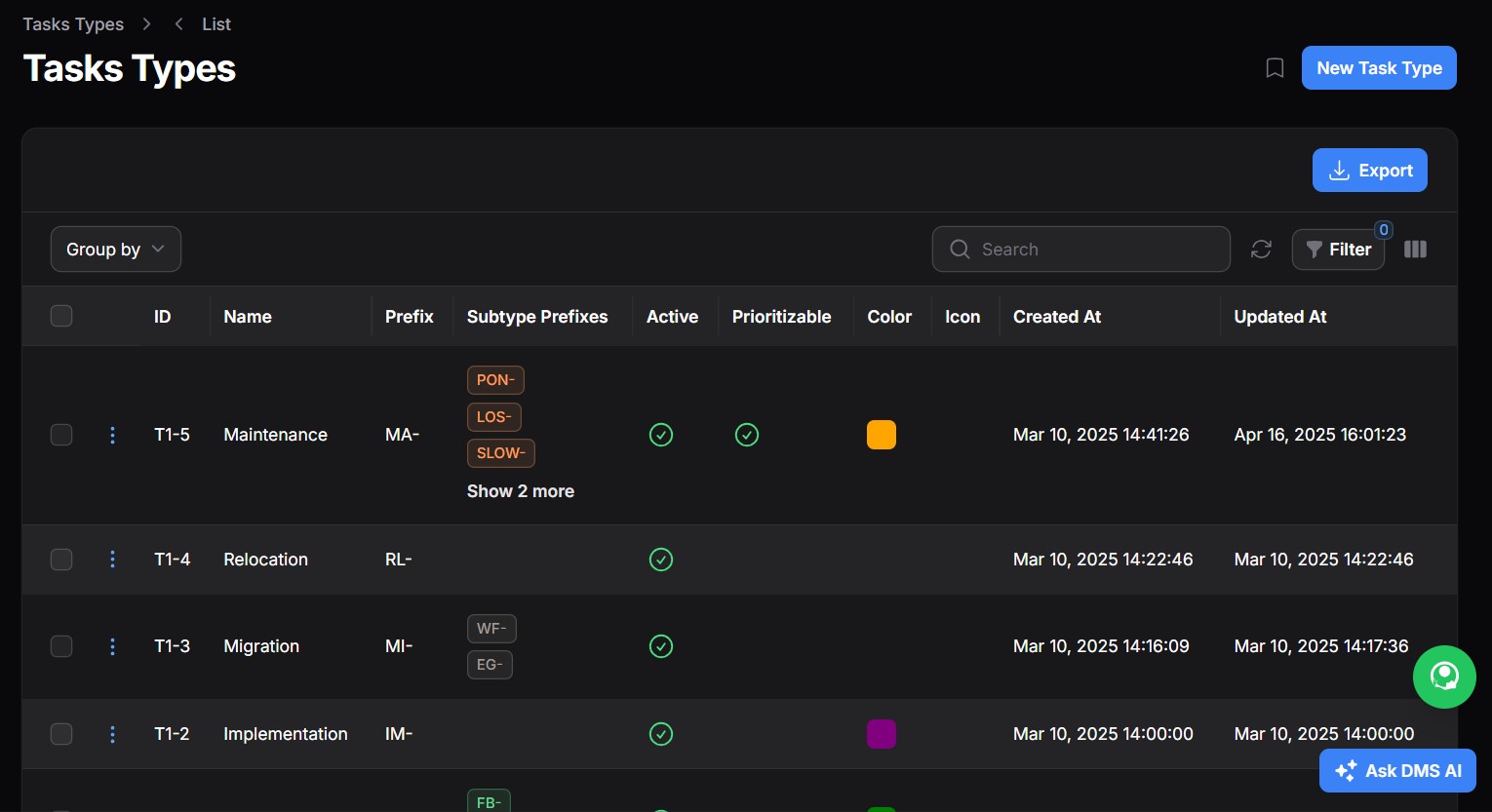Task Types define the structure, rules, and logic of how specific categories of work are created, assigned, processed, and billed within the DMS. They ensure standardization, enable automation, and support auditability across the entire workflow — from task creation to remuneration, billing, and customer feedback.

1. Task Sub Types #
What They Are #
Task Sub Types are nested under a parent Task Type and allow further breakdown for clarity and operational control. For example:
- Task Type:
Internet Installation - Task Sub Types:
Fibre,Wireless,Corporate Fibre,Site Survey, etc.
Key Fields: #
| Field | Purpose |
|---|---|
| Name | Label shown to users (e.g., Fibre) |
| Task Prefix | Used to generate task reference numbers like IN-FB-0001 |
| Active | Toggle to enable or disable this sub type |
| Description | Rich-text field to explain this sub type |
| Color/Icon | Optional – used for UI identification |
| Eligibility Settings | Toggle whether this task counts for remuneration (employee) or commission (marketer) |
2. Remuneration & Commission Rules #
Employee Remuneration #
- If enabled, the system allows defining how much a technician or staff member should earn upon completing a task under this type.
Marketer Commission #
- If enabled, marketers receive a commission based on task performance or associated charges.
- Recurring Commissions: You can define if commissions apply only on the first payment or recursively on each recurring invoice/payment.
Key Settings: #
| Option | Description |
|---|---|
| Eligible for Remuneration | Activates earning logic for employees |
| Eligible for Commission | Activates earning logic for marketers |
| Is Recurring | If enabled, commission is paid on each client payment |
| Commission Pay Delay | Set the payment number after which commission starts (e.g., after first payment) |
3. Service Level Agreements (SLAs) #
SLA configuration ensures timely service delivery and proper prioritization based on urgency.
Priority Levels: #
- Low Priority
- Medium Priority
- High Priority
Each priority defines: #
| Field | Description |
|---|---|
| Response Time | Time allowed from task creation to first staff action (e.g., 2 hours) |
| Resolution Time | Max allowed time to fully resolve the task (e.g., 24 hours) |
Note: Use decimal values (e.g., 0.5) to represent 30 minutes.
4. Mandatory Charges #
Charges that must be added to tasks of this type — typically for client billing.
Example Charges: #
- Package Fee (Unit: Mbps)
- Router Fee (Unit: Units)
- Site Survey Fee, Activation Fee, etc.
Charge Fields: #
| Field | Description |
|---|---|
| Name | Label (e.g., Router Fee) |
| Quantity Unit | Measurement unit (Mbps, Units, etc.) |
| Active | Toggle to enable or disable this charge |
| Commissionable | Should a marketer earn from this charge? |
| Description | Explain the purpose or breakdown of the fee |
💡 The actual amount is set when creating the individual task.
5. Feedback Questions #
Add structured questions that the client answers upon task completion. This improves service quality monitoring and customer satisfaction.
Examples: #
- Is your internet working?
- Are you satisfied with the cabling?
- Any suggestions for improvement?
- Do you understand the payment process?
You can add/delete/update questions for each Task Type.
6. Miscellaneous Settings #
General logic for task-type configuration such as:
- Requisition requirement
7. Managing Multiple Sub Types #
Each Task Type can include multiple Sub Types. This is useful when:
- You offer multiple versions of a service (e.g., Business vs. Residential)
- Each sub type has different fees, SLA targets, or commission rules
Use the Add Sub Type button to register new variants under a Task Type.




